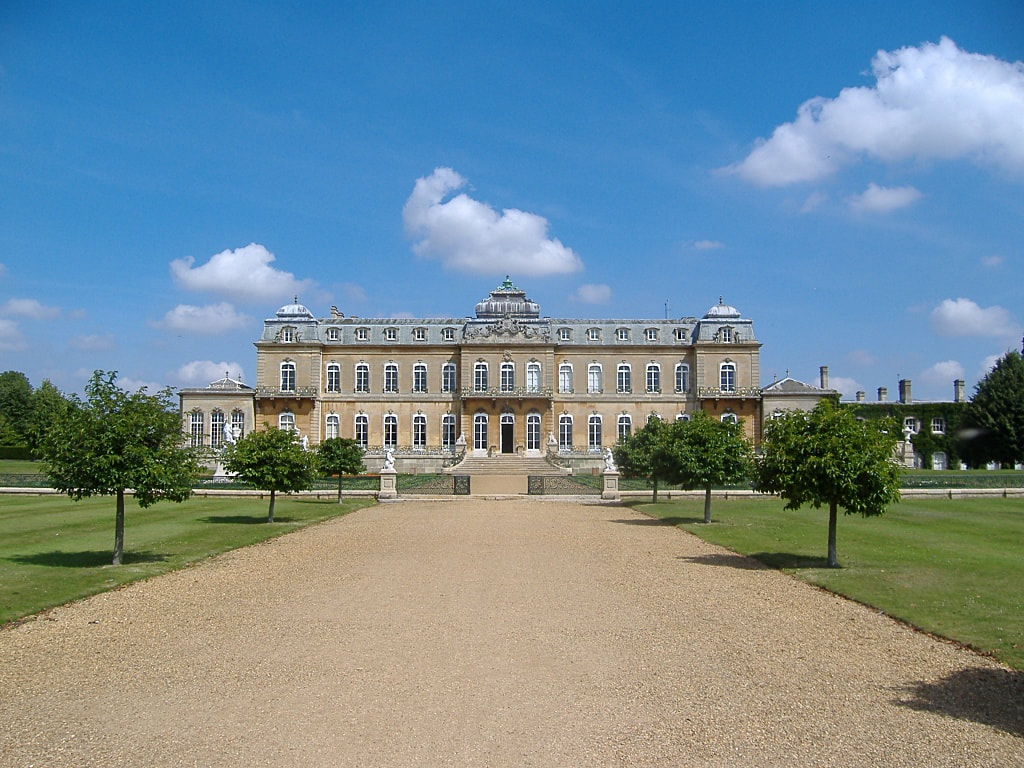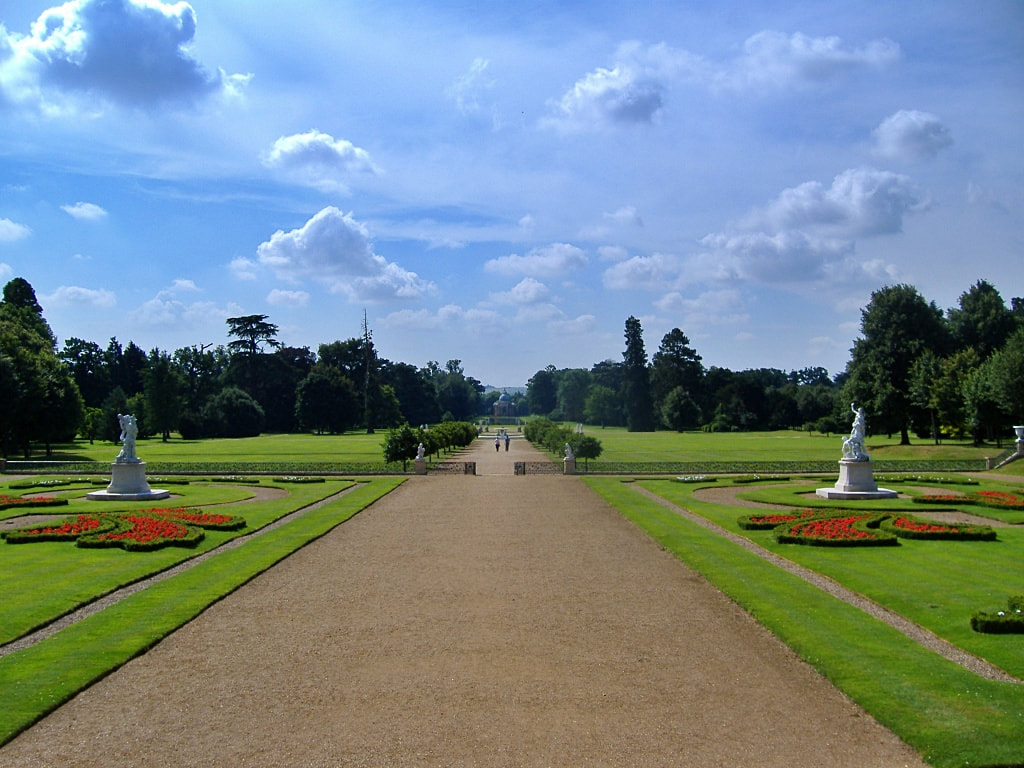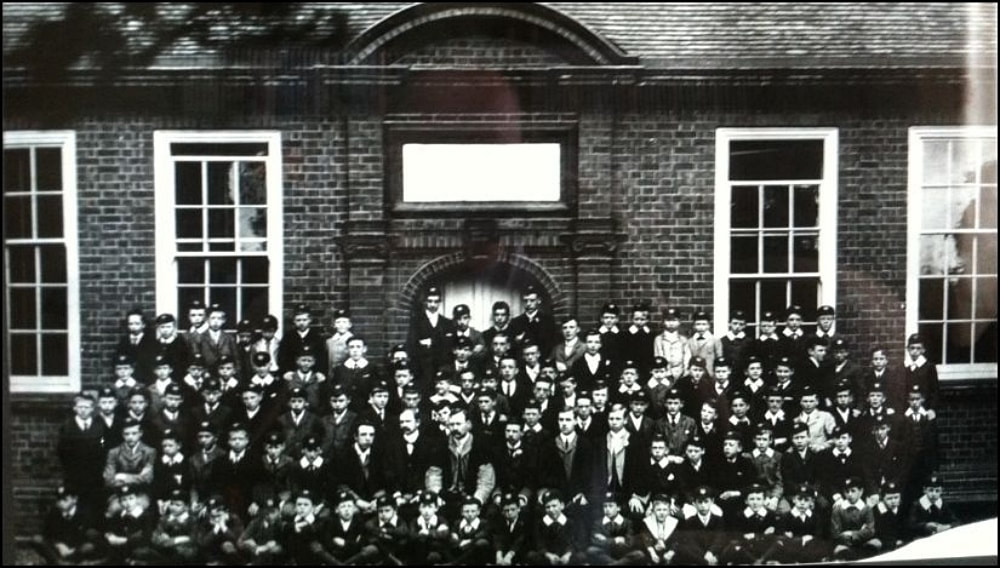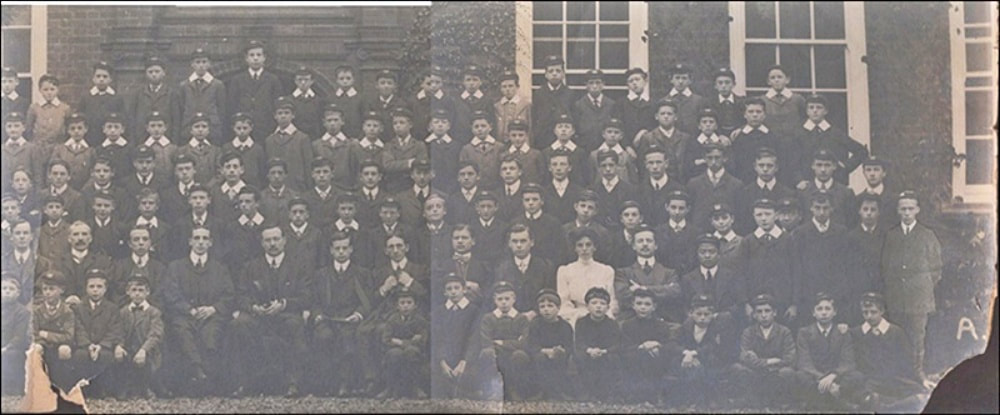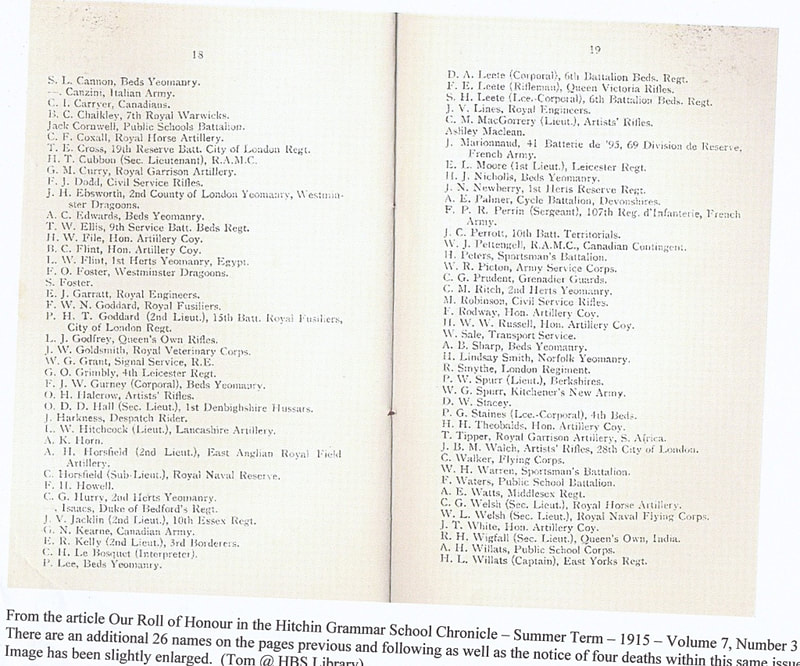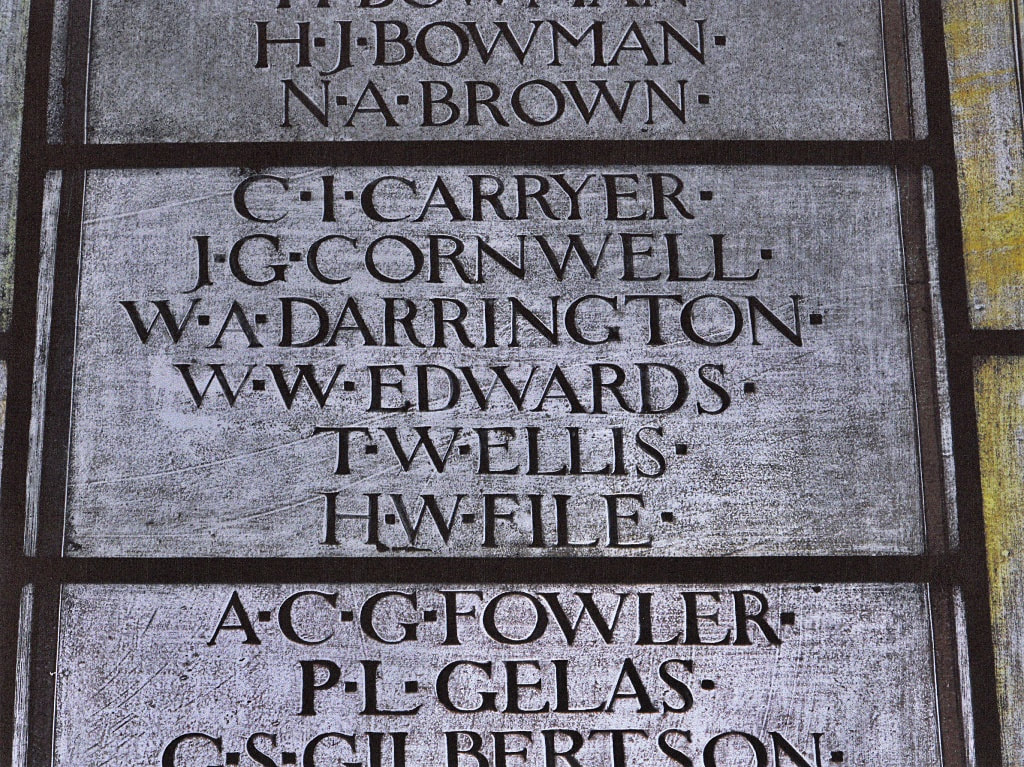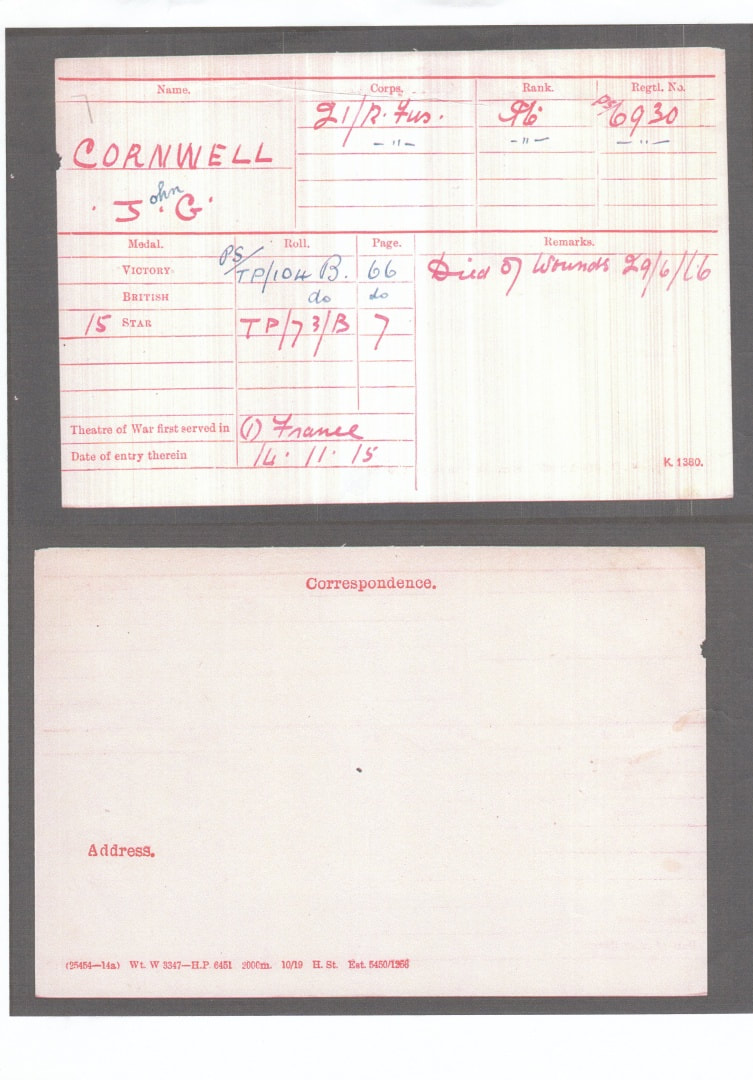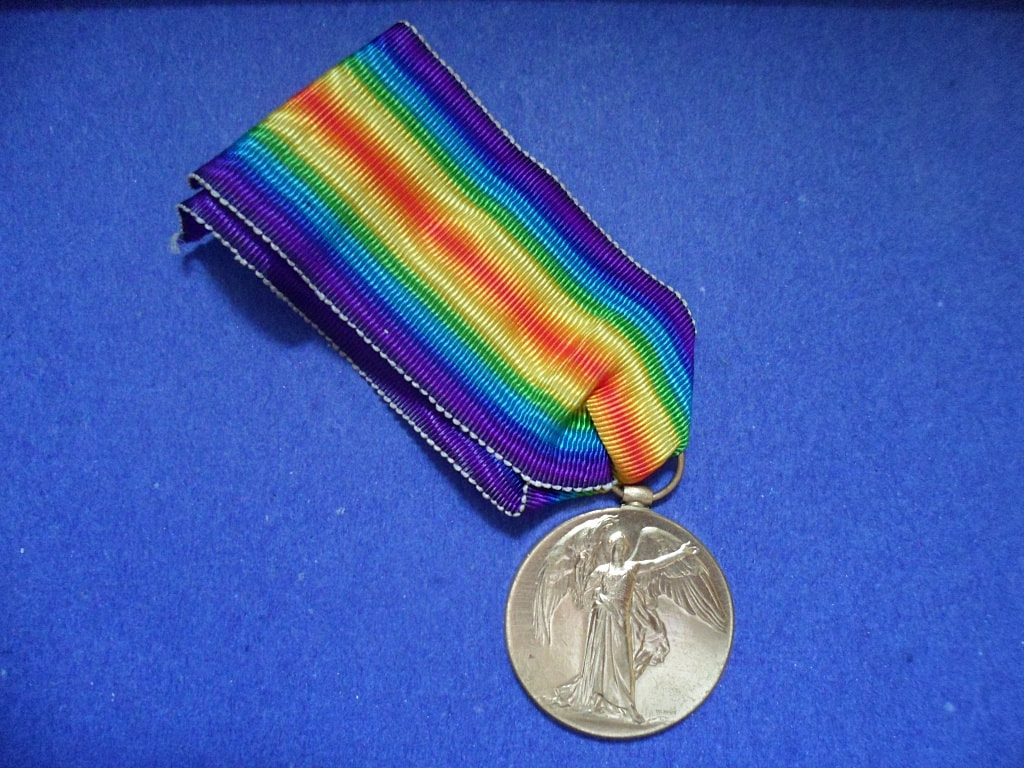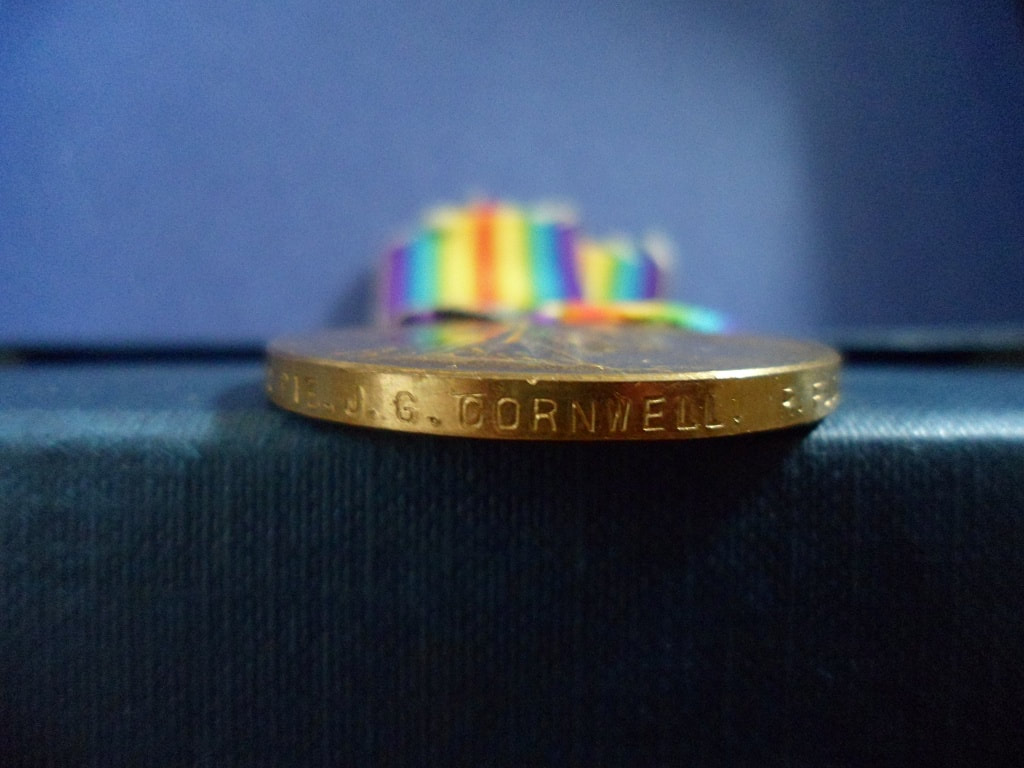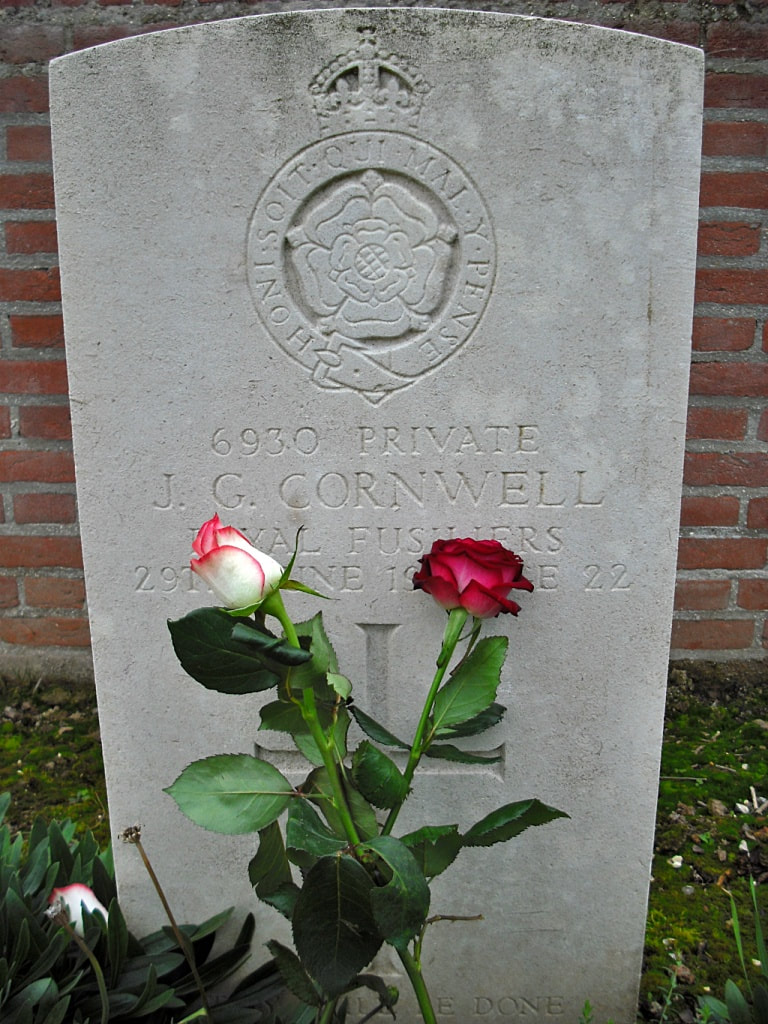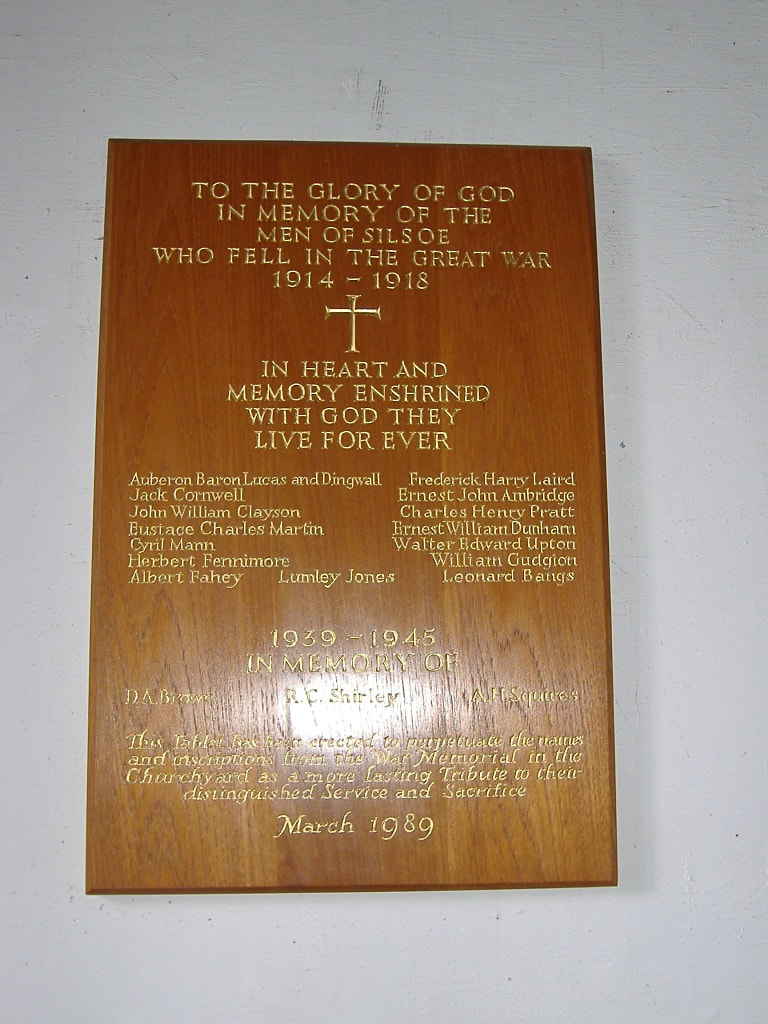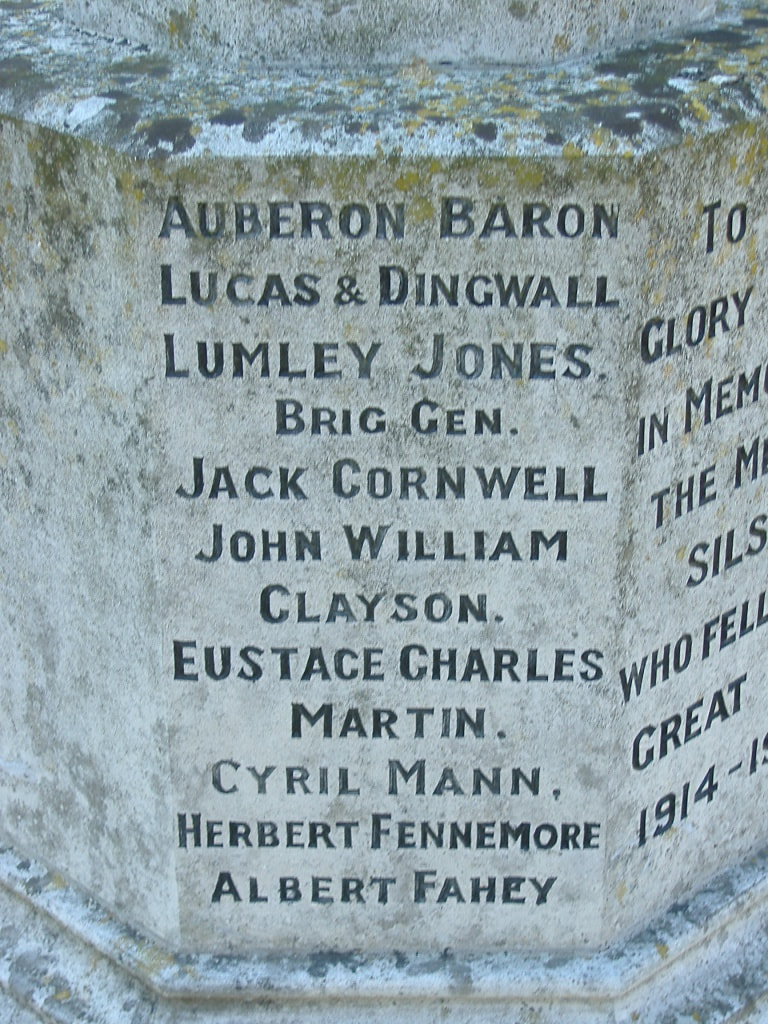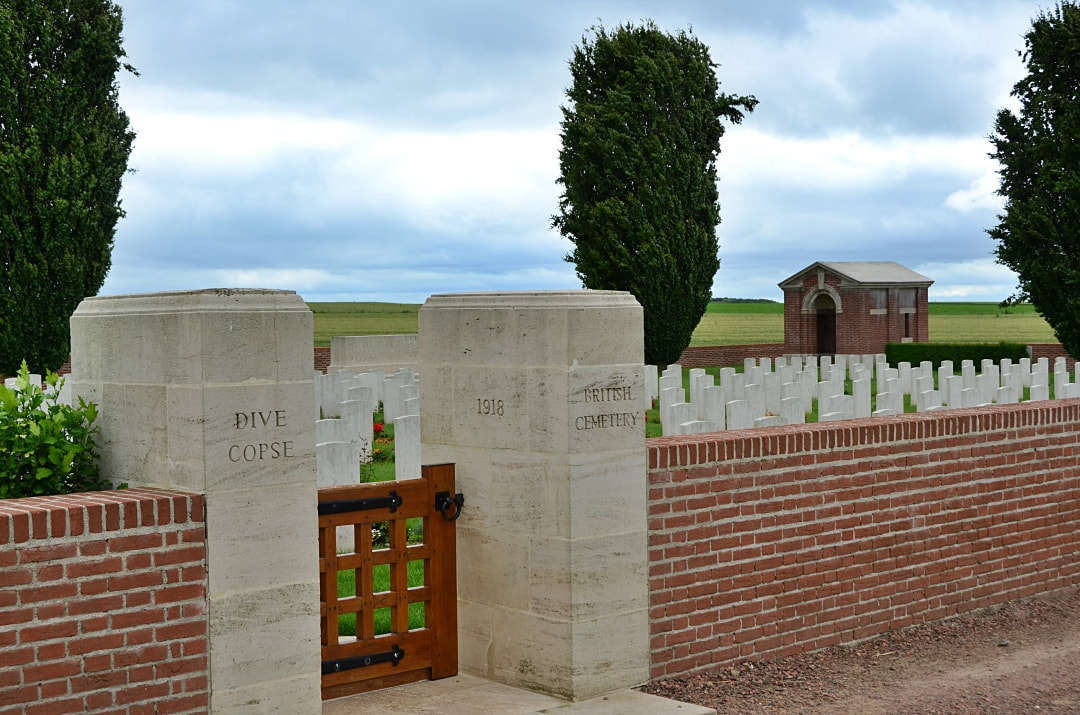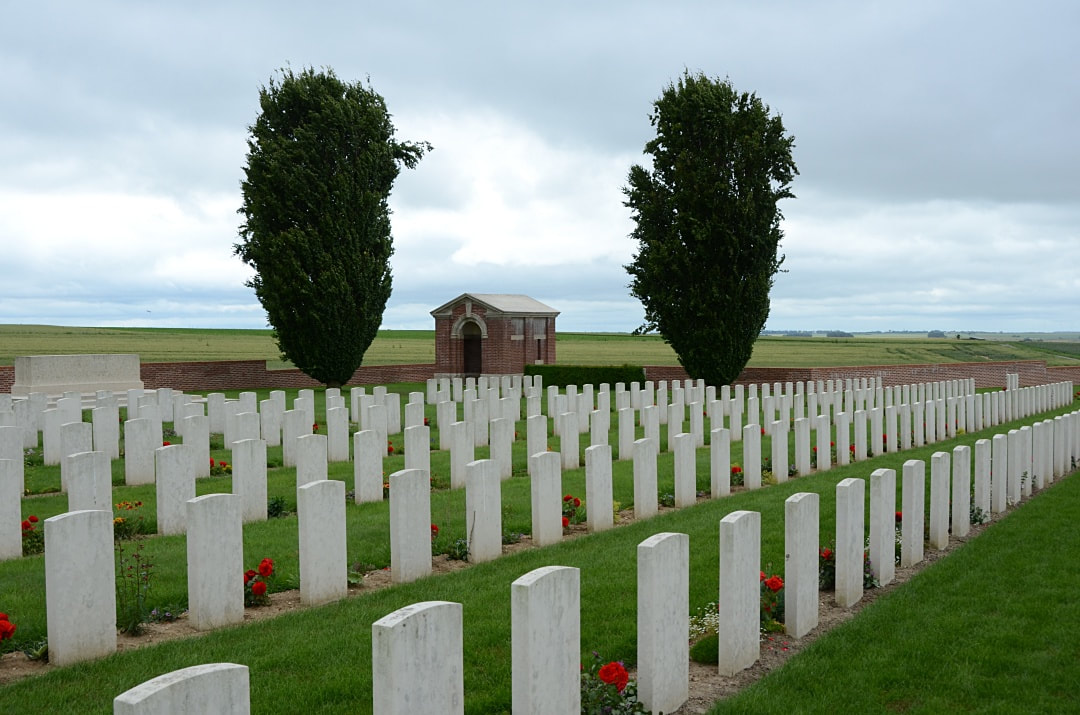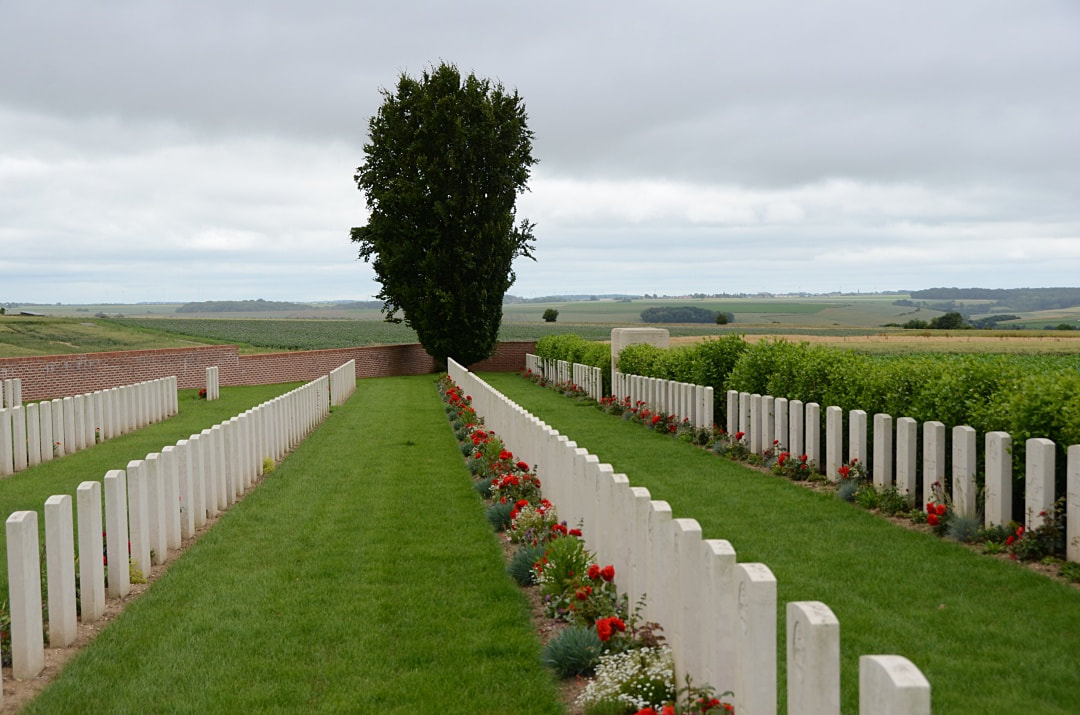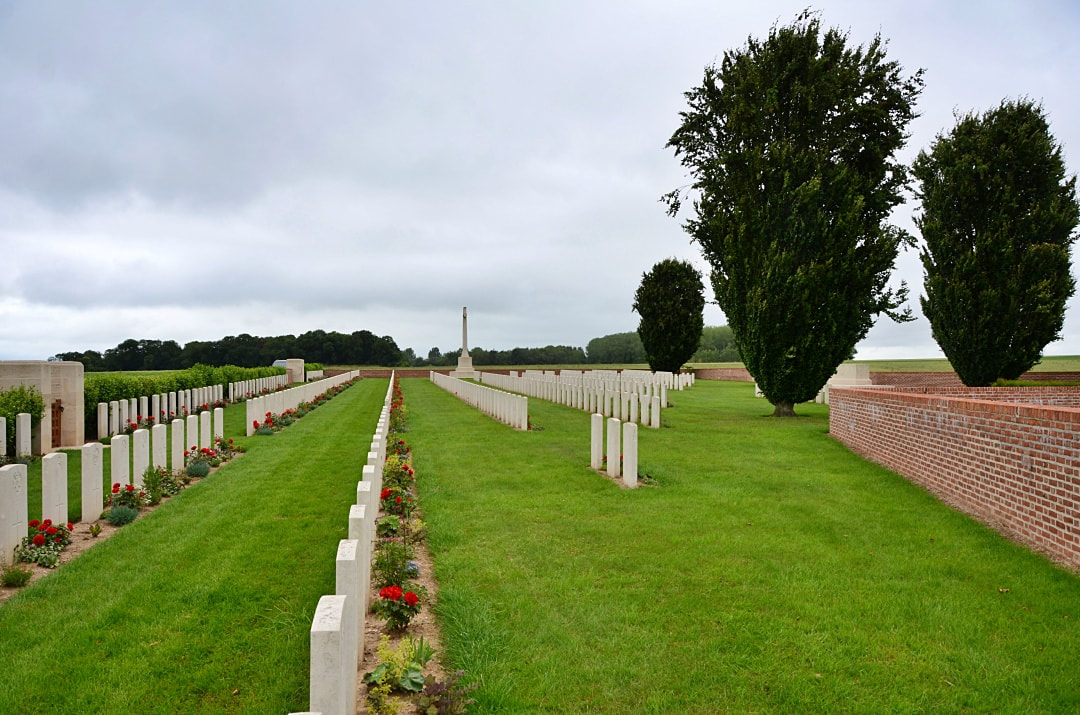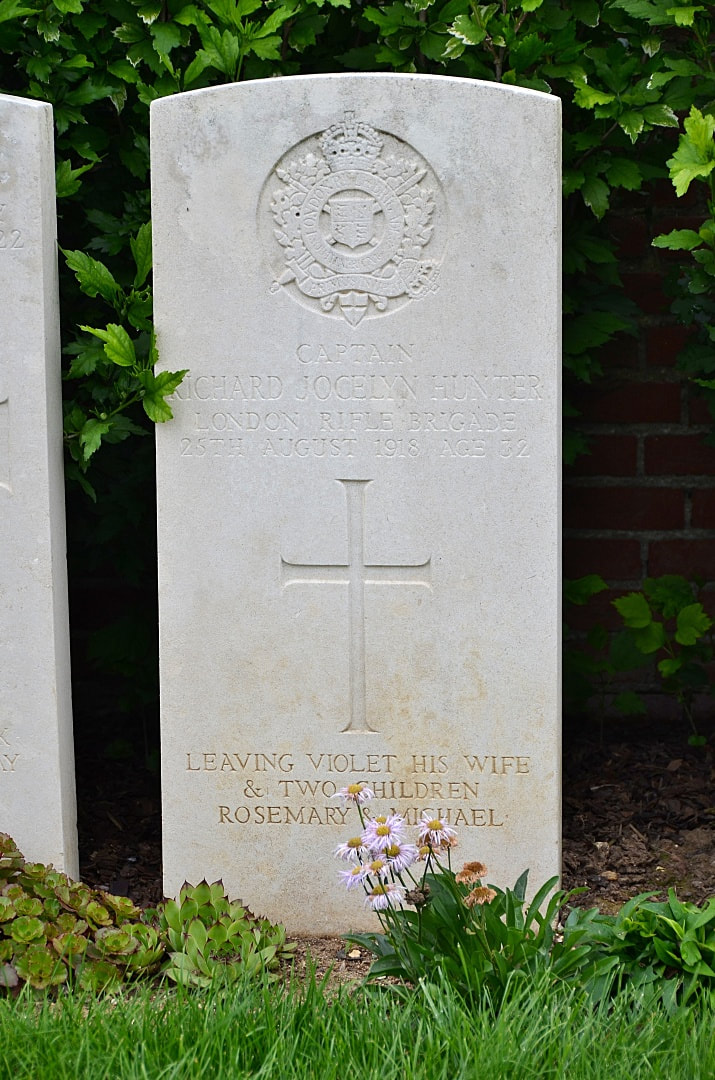Dive Copse British Cemetery
Roll of Honour
A - L

5292 Private
Robert Archibald
"C" Coy. 18th Bn. Australian Infantry
19th May 1918, aged 26.
Plot III. B. 4.
Son of Robert and Christina Archibald, of Avoca Rd., Canley Vale, New South Wales.
His headstone bears the inscription "True To Country King And Mate Leaving A Spotless Name"
A labourer prior to enlisting, he embarked from Sydney aboard HMAT Wiltshire (A18) on 22 August 1916. He was killed in action on 19 May 1918, during heavy fighting in the Morlancourt area of the Ville Sur Ancre Sector, France, aged 26.
Robert Archibald
"C" Coy. 18th Bn. Australian Infantry
19th May 1918, aged 26.
Plot III. B. 4.
Son of Robert and Christina Archibald, of Avoca Rd., Canley Vale, New South Wales.
His headstone bears the inscription "True To Country King And Mate Leaving A Spotless Name"
A labourer prior to enlisting, he embarked from Sydney aboard HMAT Wiltshire (A18) on 22 August 1916. He was killed in action on 19 May 1918, during heavy fighting in the Morlancourt area of the Ville Sur Ancre Sector, France, aged 26.

6805 Serjeant
Joseph Dan Bradshaw
6th Bn. Northamptonshire Regiment
8th August 1918, aged 31.
Plot III. H. 17.
Husband of Edith Bradshaw, of The Toll House, Wimblington, Cambs.
His headstone bears the inscription "The Parting Took My Sunshine Through Life I Shall Miss You Always"
Joseph Dan Bradshaw
6th Bn. Northamptonshire Regiment
8th August 1918, aged 31.
Plot III. H. 17.
Husband of Edith Bradshaw, of The Toll House, Wimblington, Cambs.
His headstone bears the inscription "The Parting Took My Sunshine Through Life I Shall Miss You Always"
From the Cambridgeshire Times, Friday 30th August 1918.
Wimblington: The death is notified of Serjeant Joseph Bradshaw. Northamptonshire Regiment. Who was killed in action in France age 32. The deceased soldier leaves a wife and five small children, for whom great sympathy is felt.
Details of military movement’s from 6th battalion, the Northamptonshire Regiment Diary. Place: In support North of Sailly-Le-Sec. Date: 8 August 1918, Hour 01:00 am, 6th Bn, was relieved by 9th Battalion Royal Fusilier’s 12th Division A. B. & D. Company's came out to support line north of Sailly-le-Sec. C Company to gully north of Vaux, Battalion Headquarters are with C Company. 03:30pm The 6th Battalion moved to banks north of Heilly. Date 9th August 1918, Hour 02:00am The 6th Battalion moved up in support of the 12th Division and took up position along Mericourt-Vaux Road, south of Mericourt, was spent in cleaning & organising.
Joseph Dan Bradshaw 1887 - 1918
Timeline
Birth 1887 Marshland, Norfolk to parents; Joseph Bradshaw 1858 – 1936 & Rose Margaret Carter 1859 – 1894.
1891, census, Ransonmoor, Wimblington, Cambridgeshire. Occupation Scholar.
1901, census, Newgate Doddington, Cambridgeshire. Occupation Brick layers labourer.
1907, Marriage to Edith Matilda Stuffins, Chorlton, Lancashire.
1910, Birth of daughter Elsie Bradshaw at Colchester, Essex.
1911, census, 22 Widey View, Compton, Gifford, Devon. Occupation, Hairdresser
1912, Birth of son Harry James Bradshaw at Compton, Gifford, Devon.
1914, Birth of daughter Emily Bradshaw at Farnham, Hampshire.
1916, Birth of son Cecil D Bradshaw at Wimblington, Cambridgeshire
1918, Birth of son Roy Bradshaw at Wimblington, Cambridgeshire.
Death age 31, Thursday 8th August 1918 Somme France. Killed in Action. Serjeant 6805 6th Bn. Northamptonshire Regiment
Buried at Dive Copse British Cemetery, Somme France. Grave III. H. 17
Pictures and information courtesy of Andy Towning
Wimblington: The death is notified of Serjeant Joseph Bradshaw. Northamptonshire Regiment. Who was killed in action in France age 32. The deceased soldier leaves a wife and five small children, for whom great sympathy is felt.
Details of military movement’s from 6th battalion, the Northamptonshire Regiment Diary. Place: In support North of Sailly-Le-Sec. Date: 8 August 1918, Hour 01:00 am, 6th Bn, was relieved by 9th Battalion Royal Fusilier’s 12th Division A. B. & D. Company's came out to support line north of Sailly-le-Sec. C Company to gully north of Vaux, Battalion Headquarters are with C Company. 03:30pm The 6th Battalion moved to banks north of Heilly. Date 9th August 1918, Hour 02:00am The 6th Battalion moved up in support of the 12th Division and took up position along Mericourt-Vaux Road, south of Mericourt, was spent in cleaning & organising.
Joseph Dan Bradshaw 1887 - 1918
Timeline
Birth 1887 Marshland, Norfolk to parents; Joseph Bradshaw 1858 – 1936 & Rose Margaret Carter 1859 – 1894.
1891, census, Ransonmoor, Wimblington, Cambridgeshire. Occupation Scholar.
1901, census, Newgate Doddington, Cambridgeshire. Occupation Brick layers labourer.
1907, Marriage to Edith Matilda Stuffins, Chorlton, Lancashire.
1910, Birth of daughter Elsie Bradshaw at Colchester, Essex.
1911, census, 22 Widey View, Compton, Gifford, Devon. Occupation, Hairdresser
1912, Birth of son Harry James Bradshaw at Compton, Gifford, Devon.
1914, Birth of daughter Emily Bradshaw at Farnham, Hampshire.
1916, Birth of son Cecil D Bradshaw at Wimblington, Cambridgeshire
1918, Birth of son Roy Bradshaw at Wimblington, Cambridgeshire.
Death age 31, Thursday 8th August 1918 Somme France. Killed in Action. Serjeant 6805 6th Bn. Northamptonshire Regiment
Buried at Dive Copse British Cemetery, Somme France. Grave III. H. 17
Pictures and information courtesy of Andy Towning
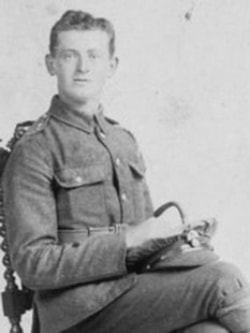
G/17463 Private
Benjamin Cropper Bury
4th Bn. Royal Fusiliers
11th July 1916, aged 24.
Plot II. E. 19.
Son of Benjamin and Mary C. Bury, of 15, Byron's Lane, Macclesfield, Cheshire.
His headstone bears the inscription "He Was A Soldier Of The Cross A Follower Of The Lamb"
Picture courtesy of Susan Mitchell
Benjamin Cropper Bury
4th Bn. Royal Fusiliers
11th July 1916, aged 24.
Plot II. E. 19.
Son of Benjamin and Mary C. Bury, of 15, Byron's Lane, Macclesfield, Cheshire.
His headstone bears the inscription "He Was A Soldier Of The Cross A Follower Of The Lamb"
Picture courtesy of Susan Mitchell
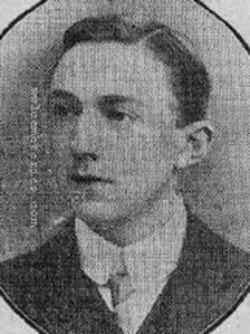
80611 Gunner
Bert Mayhew Chapman
142nd Siege Bty. Royal Garrison Artillery
2nd September 1916
Plot II. H. 7.
Bert Mayhew Chapman
142nd Siege Bty. Royal Garrison Artillery
2nd September 1916
Plot II. H. 7.
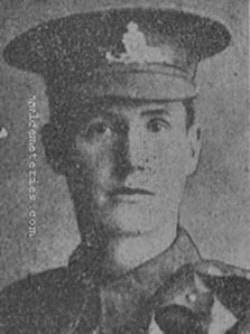
132 Gunner
John William Coates
158th Bty. Royal Field Artillery
20th July 1916, aged 32.
Plot II. E. 4.
Husband of N. Coates, of 85, Nairne St., Burnley.
His headstone bears the inscription "Thy Will Be Done"
Prior to enlisting, John worked as a window cleaner.
John William Coates
158th Bty. Royal Field Artillery
20th July 1916, aged 32.
Plot II. E. 4.
Husband of N. Coates, of 85, Nairne St., Burnley.
His headstone bears the inscription "Thy Will Be Done"
Prior to enlisting, John worked as a window cleaner.
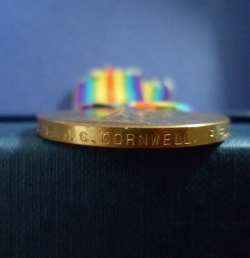
6930 Private
John George Cornwell
11th Bn. Royal Fusiliers
29th June 1916, aged 22.
Plot II. A. 21.
Son of William John and L. Cornwell, of Silsoe, Ampthill, Beds.
His headstone bears the inscription "Thy Will Be Done"
John George Cornwell
11th Bn. Royal Fusiliers
29th June 1916, aged 22.
Plot II. A. 21.
Son of William John and L. Cornwell, of Silsoe, Ampthill, Beds.
His headstone bears the inscription "Thy Will Be Done"
Our interest in "Jack" Cornwell and his war started in October 2005 when we managed to obtain his victory medal online. We have pieced together his life prior to his enlistment in 1915 and his tragic death two days before the Battle of the Somme. We have spent many hours in the main library in Bedford going through the newspapers of the time and also engaged a genealogist who filled in many of the gaps for us. We have also spent many hours online, which at times has been more problematic due to him having a similar name as "Jack Travers Cornwell", the boy sailor who won a Victoria cross. This is a tribute to Jack and the thousands like him who went "to do their bit" and were tragically killed, maimed psychologically or physically during that terrible conflict.
The biography has many photographs, but unfortunately we have been unable to locate a picture of Jack. There is a picture of Hitchin Boys School circa 1910 and he is probably in that photograph somewhere.
John (Jack) George Cornwell was born on the 03/01/1894 at 4 Fishpond Road, Hitchin, Hertfordshire. He was the second son of William John Cornwell and Lizzie Cornwell nee Haddow. Jack had one older brother, Archibald William Cornwell who was born in 1890. The family lived at Wrest Park Farm which was adjacent to Wrest Park near Silsoe in Bedfordshire. Wrest Park is a large stately home and was owned by the wealthy de Grey family. Lord Lucas was the owner during the early part of the twentieth century but he was killed during the Great War and the estate was subsequently sold. Jack's Grandfather Archibald Haddow was employed as the Estate Manager until 1914 when Jack succeeded him at the age of 20 years.
We have very little information of Jack during his early years, though we do know that he was given a prize at St. James church in Silsoe when he was eight years old along with his brother Archibald. The next time his name appears was on the attendance register at Hitchin boys school. The register revealed that although Jack's name first appears as an addition in pencil at the bottom of the page for 1907, he did not actually start school until 16th Jan 1908. His last entry occurs in September 1910, so he was educated at the school for two and a half years. His attendance was quite good but we understand that in one term he was absent for over fifty days which possibly suggests a long illness, but sadly the records do not provide the reason for his absence.
On the 02/09/1914 Jack's brother Archibald married Mabel Wilson at Clifton Baptist chapel and Jack was the best man at the wedding. In May 1915 Jack joined the 21st Public Schools Battalion, Royal Fusiliers and went to France in the November. The battalion disembarked on the 14/11/1915 at Calais via Folkestone on the S.S. Princess Victoria. They then went by train to Boulogne where they rested for a couple of days before marching to Bethune. The rest of the war diaries for the next couple of months shows the battalion in the Bethune and Festubert area and being involved in a few isolated skirmishes. The 21st Battalion was disbanded in April 1916 and Jack was drafted into the 11th Battalion Royal Fusiliers. The battalion was moved up to just behind the lines in Chipilly in readiness for the Somme battle on the 01/07/1916. On June 25th 1916 the battalion moved into support trenches at Carnoy, where the allied forces had already commenced their bombardment of the German lines. During the German retaliation which took place between the 25th and 30th, Jack's battalion lost eight men and forty six wounded, three men were also found to be suffering from shell shock. Jack was one of the casualties, he had been wounded in the right arm and left leg by shrapnel. He was taken to the XIV Corps Main Dressing Station and he died one day later. The local paper reported the following:
" The death of Private John George (Jack) Cornwell reported on Tuesday caused the deepest regret in Silsoe. He had lived with his Mother and Grandfather (Mr A.G. Haddow) in Wrest Park from infancy. In May 1915, he joined the Public Schools Battalion Royal Fusiliers and went to France in the following November. He was wounded by shrapnel in the right arm and left leg on June 28th, and was taken to a field dressing station but died on the following day. He succeeded his Grandfather at the Wrest Park Estate Office in May 1914 but when war broke out he was most eager to do his bit. His last letter home said he was waiting to take part in the "great push" but had a presentiment that he would not live to return to his friends. He was 22 years of age. The greatest sympathy is felt for his sorrowing Mother and heart-broken Grandfather".
Another tribute was also reported in the paper
"In connection with the death of Private John (Jack) George Cornwell, Public Schools Battalion Royal Fusiliers, who from infancy made his home with his Mother and Grandfather (Mr A.G. Haddow) at Wrest Park. The summer number of the Hitchin Grammar School Chronicle contains the following tribute: Jack had a lovable disposition and when at school it did one good to see his frank and open face and cheerful smile. Well, we remember how at one of our prize distributions, Jack went up to receive the special prize for public spirit, for which he had been selected by his fellow scholars. The overwhelming majority by which he was chosen was a revelation of the affection with which he inspired the whole school and if there had been any doubts on that score, the ringing cheers with which he was greeted would have been sufficient to dispel them. But Jack Cornwell felt the call of his country as clearly and unmistakably as five or six years before he had felt that of the school, and he carried his public spirit with him to the end. That must be the consolation for the sorrowing Mother and brother, to whom we tender our deepest sympathy".
We have recently managed to obtain his will that he wrote just before his death. In his own writing it stated "In the event of my death I give the whole of my personal property and effects to my dear mother - (Mrs. L. Cornwell of Wrest Park Farm, Silsoe, Ampthill, Bedfordshire) to be at her disposal absolutely".
Jack was awarded three medals, the Victory Medal, 14/15 Star and the British War Medal. His regimental number was PS/6930, the prefix refers to Public Schools.
The biography has many photographs, but unfortunately we have been unable to locate a picture of Jack. There is a picture of Hitchin Boys School circa 1910 and he is probably in that photograph somewhere.
John (Jack) George Cornwell was born on the 03/01/1894 at 4 Fishpond Road, Hitchin, Hertfordshire. He was the second son of William John Cornwell and Lizzie Cornwell nee Haddow. Jack had one older brother, Archibald William Cornwell who was born in 1890. The family lived at Wrest Park Farm which was adjacent to Wrest Park near Silsoe in Bedfordshire. Wrest Park is a large stately home and was owned by the wealthy de Grey family. Lord Lucas was the owner during the early part of the twentieth century but he was killed during the Great War and the estate was subsequently sold. Jack's Grandfather Archibald Haddow was employed as the Estate Manager until 1914 when Jack succeeded him at the age of 20 years.
We have very little information of Jack during his early years, though we do know that he was given a prize at St. James church in Silsoe when he was eight years old along with his brother Archibald. The next time his name appears was on the attendance register at Hitchin boys school. The register revealed that although Jack's name first appears as an addition in pencil at the bottom of the page for 1907, he did not actually start school until 16th Jan 1908. His last entry occurs in September 1910, so he was educated at the school for two and a half years. His attendance was quite good but we understand that in one term he was absent for over fifty days which possibly suggests a long illness, but sadly the records do not provide the reason for his absence.
On the 02/09/1914 Jack's brother Archibald married Mabel Wilson at Clifton Baptist chapel and Jack was the best man at the wedding. In May 1915 Jack joined the 21st Public Schools Battalion, Royal Fusiliers and went to France in the November. The battalion disembarked on the 14/11/1915 at Calais via Folkestone on the S.S. Princess Victoria. They then went by train to Boulogne where they rested for a couple of days before marching to Bethune. The rest of the war diaries for the next couple of months shows the battalion in the Bethune and Festubert area and being involved in a few isolated skirmishes. The 21st Battalion was disbanded in April 1916 and Jack was drafted into the 11th Battalion Royal Fusiliers. The battalion was moved up to just behind the lines in Chipilly in readiness for the Somme battle on the 01/07/1916. On June 25th 1916 the battalion moved into support trenches at Carnoy, where the allied forces had already commenced their bombardment of the German lines. During the German retaliation which took place between the 25th and 30th, Jack's battalion lost eight men and forty six wounded, three men were also found to be suffering from shell shock. Jack was one of the casualties, he had been wounded in the right arm and left leg by shrapnel. He was taken to the XIV Corps Main Dressing Station and he died one day later. The local paper reported the following:
" The death of Private John George (Jack) Cornwell reported on Tuesday caused the deepest regret in Silsoe. He had lived with his Mother and Grandfather (Mr A.G. Haddow) in Wrest Park from infancy. In May 1915, he joined the Public Schools Battalion Royal Fusiliers and went to France in the following November. He was wounded by shrapnel in the right arm and left leg on June 28th, and was taken to a field dressing station but died on the following day. He succeeded his Grandfather at the Wrest Park Estate Office in May 1914 but when war broke out he was most eager to do his bit. His last letter home said he was waiting to take part in the "great push" but had a presentiment that he would not live to return to his friends. He was 22 years of age. The greatest sympathy is felt for his sorrowing Mother and heart-broken Grandfather".
Another tribute was also reported in the paper
"In connection with the death of Private John (Jack) George Cornwell, Public Schools Battalion Royal Fusiliers, who from infancy made his home with his Mother and Grandfather (Mr A.G. Haddow) at Wrest Park. The summer number of the Hitchin Grammar School Chronicle contains the following tribute: Jack had a lovable disposition and when at school it did one good to see his frank and open face and cheerful smile. Well, we remember how at one of our prize distributions, Jack went up to receive the special prize for public spirit, for which he had been selected by his fellow scholars. The overwhelming majority by which he was chosen was a revelation of the affection with which he inspired the whole school and if there had been any doubts on that score, the ringing cheers with which he was greeted would have been sufficient to dispel them. But Jack Cornwell felt the call of his country as clearly and unmistakably as five or six years before he had felt that of the school, and he carried his public spirit with him to the end. That must be the consolation for the sorrowing Mother and brother, to whom we tender our deepest sympathy".
We have recently managed to obtain his will that he wrote just before his death. In his own writing it stated "In the event of my death I give the whole of my personal property and effects to my dear mother - (Mrs. L. Cornwell of Wrest Park Farm, Silsoe, Ampthill, Bedfordshire) to be at her disposal absolutely".
Jack was awarded three medals, the Victory Medal, 14/15 Star and the British War Medal. His regimental number was PS/6930, the prefix refers to Public Schools.
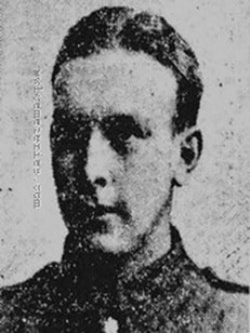
15241 Private
Arthur Shaw Damsell
1st Coy. 17th Bn. The King's (Liverpool Regiment)
11th July 1916, aged 21.
Plot II. E. 23.
Son of Arthur and Mary Elizabeth Damsell, of "Holmfield," Victoria Park, Wavertree, Liverpool.
His headstone bears the inscription "All He Had Hoped For All He Had He Gave To Save Mankind"
Arthur Shaw Damsell
1st Coy. 17th Bn. The King's (Liverpool Regiment)
11th July 1916, aged 21.
Plot II. E. 23.
Son of Arthur and Mary Elizabeth Damsell, of "Holmfield," Victoria Park, Wavertree, Liverpool.
His headstone bears the inscription "All He Had Hoped For All He Had He Gave To Save Mankind"
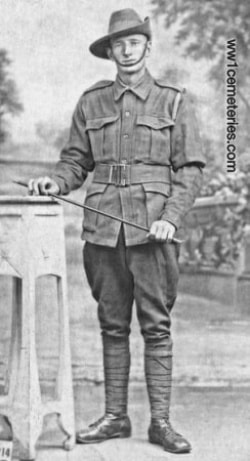
4695 Private
Angas Lawrence Day
32nd Bn. Australian Infantry, A. I. F.
21st June 1918, aged 26.
Special Memorial 2. South of War Stone.
Son of John and Mary Augusta Day, of Inglewood, South Australia. Native of Houghton, South Australia.
The inscription on his headstone reads; "While you lie in peaceful sleep, your memory we will always keep."
A labourer of Inglewood, SA, prior to enlistment, he embarked with the 12th Reinforcements of the 27th Battalion on 11 April 1916, leaving on HMAT Aeneas from Adelaide. He later transferred to the 32nd Battalion. Pte Day was killed in action on 21 June 1918 in France. He has no known grave and his name is recorded on the Special Memorial 2 at the Dive Copse British Cemetery.
Angas Lawrence Day
32nd Bn. Australian Infantry, A. I. F.
21st June 1918, aged 26.
Special Memorial 2. South of War Stone.
Son of John and Mary Augusta Day, of Inglewood, South Australia. Native of Houghton, South Australia.
The inscription on his headstone reads; "While you lie in peaceful sleep, your memory we will always keep."
A labourer of Inglewood, SA, prior to enlistment, he embarked with the 12th Reinforcements of the 27th Battalion on 11 April 1916, leaving on HMAT Aeneas from Adelaide. He later transferred to the 32nd Battalion. Pte Day was killed in action on 21 June 1918 in France. He has no known grave and his name is recorded on the Special Memorial 2 at the Dive Copse British Cemetery.
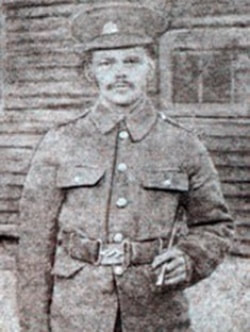
22531 Private
Harry Evans
8th Bn. Suffolk Regiment
20th July 1916
Plot II. E. 10
Picture courtesy of granddaughter's, Constance Curzon and Marjory Edwards
Harry Evans
8th Bn. Suffolk Regiment
20th July 1916
Plot II. E. 10
Picture courtesy of granddaughter's, Constance Curzon and Marjory Edwards
38781 Gunner William Flipping, "D" Battery, 83rd Brigade, Royal Field Artillery, died 19th July 1916.
Remembered by his Great Grandson, Paul Richardson
Remembered by his Great Grandson, Paul Richardson
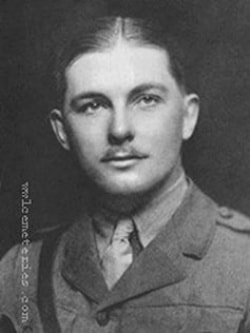
Lieutenant
James Cameron Forster-Brown
12th Bn. The Rifle Brigade
27th August 1916, aged 22.
Plot II. G. 23.
Brother of Mrs. Doris T. Ashley Smith, of "Mesylls," Chiddingfold, Godalming.
His headstone bears the inscription "À Bientôt"
James Cameron Forster-Brown
12th Bn. The Rifle Brigade
27th August 1916, aged 22.
Plot II. G. 23.
Brother of Mrs. Doris T. Ashley Smith, of "Mesylls," Chiddingfold, Godalming.
His headstone bears the inscription "À Bientôt"

1970 Private
Edmund William Henry Greenway
4th Regt. South African Infantry
17th July 1916, aged 21.
Plot II. B. 17.
Died of wounds suffered at Delville Wood
Picture courtesy of Stuart Burgess
Edmund William Henry Greenway
4th Regt. South African Infantry
17th July 1916, aged 21.
Plot II. B. 17.
Died of wounds suffered at Delville Wood
Picture courtesy of Stuart Burgess

Captain
George Robert Hitchin
2nd/1st (West Lancs) Field Ambulance, Royal Army Medical Corps
14th August 1916, aged 38.
Plot II. F. 25.
Son of Robert and Dora Pickering Hitchin, of Burnley. M.B., Ch.B., Victoria University, Manchester. Medical Practitioner, Tottington, Bury, Lancs.
His headstone bears the inscription "I Go Forward And Finish Rather Than Stand Back And Live To Regret"
The information below supplied by 'The Ellesmerian Club', the alumni organisation for Ellesmere College where George was a pupil.
George Robert Hitchin
2nd/1st (West Lancs) Field Ambulance, Royal Army Medical Corps
14th August 1916, aged 38.
Plot II. F. 25.
Son of Robert and Dora Pickering Hitchin, of Burnley. M.B., Ch.B., Victoria University, Manchester. Medical Practitioner, Tottington, Bury, Lancs.
His headstone bears the inscription "I Go Forward And Finish Rather Than Stand Back And Live To Regret"
The information below supplied by 'The Ellesmerian Club', the alumni organisation for Ellesmere College where George was a pupil.
George Robert Hitchin, the only son of Robert, a pharmacist and his wife, Dora was born on 30th December 1878 in Burnley, Lancashire. He was baptized on 21st September 1879 and the Parish Records show the family lived at St. James Street. Over the next four years, three younger sisters were born and, by the time of the 1891 Census, the family had moved to Ormerod Street.
George was educated at a school in Red Lion Street, then the Burnley National School before he was admitted to Burnley Grammar School where he spent three years prior to his admittance to Ellesmere College, north Shropshire on 17th January 1896.
There were twenty nine new boys that term and the nominal roll records one hundred and eighty nine boys in the college. George was allocated to the ‘Harold’ dormitory and took up his place in Form V under the instruction of Mr. Hare, one of the longest serving members of staff at that time. As George’s time at Ellesmere only extended to two terms it is hardly surprising that there are very few references to him in the college records.
There are no records of him playing in any sporting teams, nor of any academic prizes being awarded or examinations passed. He was, immediately on his arrival, elected a member of the Debating Society but there is no record of him speaking at any meeting! George left the college at the end of the Summer Term 1896 and went on to study medicine at Owens College, Manchester.
The 1901 Census records him living in a boarding house whilst he was a medical student there. He graduated Bachelor of Chemistry and Bachelor of Medicine from Victoria University, Manchester two years later. He registered with the British Medical Association on 8th August 1903 and was to spend several years as a surgeon on steamships sailing between England and the Far East and South American ports. On his return to England he worked in various medical practices in Whalley and Wetherby before establishing his own practice in Tottington, Bury.
The 1911 Census recorded him living at Ivy Grove, Tottington with his sister, Agnes Annie.
He enlisted on 2nd November 1914 and was granted a commission in the Royal Army Medical Corps. He was attached to the 1/2nd East Lancashire (Reserve) Field Ambulance and was promoted full Lieutenant on 22ndNovember 1914. After six months continuous service he was promoted Captain on 22nd May 1915.
He had been due to sail for the Dardanelles on the “Prince Edward” but, at the last moment, he was instead instructed to take command of the Military Camp and Detention Centre at Forest Row, Sussex. This last-minute change of instruction almost certainly saved his life as “The Prince Edward” sank on 13th August 1915 with the loss of over nine hundred lives.
Robert saw active service in France and Flanders where he served with the British Expeditionary Force. He was killed in action on 14th August 1916 whilst tending the wounded in front line trenches during the operations on The Somme.
He was buried in Dive Copse, a wood off the main road from Bray to Corbie, near Sailly-le-Sec. One of his men wrote:
“How much we have lost we cannot estimate. His life to us is a peerless example of all that makes a soldier and gentleman. His soldierly regularity, intrepid zeal, noble purpose, command our respect. Cool, calm, collected he took what occasion brought, smiled and made the best of it, inspiring confidence in all. To know him was a privilege, to be conversant with him an education, to follow him a pleasure, to obey him a sweet necessity”.
George’s name was never engraved on the War Memorial at Ellesmere. This omission, despite the best endeavours of the college to track all those who had served or died on active service, was remedied by the Ellesmerian Club in 2017.
George was educated at a school in Red Lion Street, then the Burnley National School before he was admitted to Burnley Grammar School where he spent three years prior to his admittance to Ellesmere College, north Shropshire on 17th January 1896.
There were twenty nine new boys that term and the nominal roll records one hundred and eighty nine boys in the college. George was allocated to the ‘Harold’ dormitory and took up his place in Form V under the instruction of Mr. Hare, one of the longest serving members of staff at that time. As George’s time at Ellesmere only extended to two terms it is hardly surprising that there are very few references to him in the college records.
There are no records of him playing in any sporting teams, nor of any academic prizes being awarded or examinations passed. He was, immediately on his arrival, elected a member of the Debating Society but there is no record of him speaking at any meeting! George left the college at the end of the Summer Term 1896 and went on to study medicine at Owens College, Manchester.
The 1901 Census records him living in a boarding house whilst he was a medical student there. He graduated Bachelor of Chemistry and Bachelor of Medicine from Victoria University, Manchester two years later. He registered with the British Medical Association on 8th August 1903 and was to spend several years as a surgeon on steamships sailing between England and the Far East and South American ports. On his return to England he worked in various medical practices in Whalley and Wetherby before establishing his own practice in Tottington, Bury.
The 1911 Census recorded him living at Ivy Grove, Tottington with his sister, Agnes Annie.
He enlisted on 2nd November 1914 and was granted a commission in the Royal Army Medical Corps. He was attached to the 1/2nd East Lancashire (Reserve) Field Ambulance and was promoted full Lieutenant on 22ndNovember 1914. After six months continuous service he was promoted Captain on 22nd May 1915.
He had been due to sail for the Dardanelles on the “Prince Edward” but, at the last moment, he was instead instructed to take command of the Military Camp and Detention Centre at Forest Row, Sussex. This last-minute change of instruction almost certainly saved his life as “The Prince Edward” sank on 13th August 1915 with the loss of over nine hundred lives.
Robert saw active service in France and Flanders where he served with the British Expeditionary Force. He was killed in action on 14th August 1916 whilst tending the wounded in front line trenches during the operations on The Somme.
He was buried in Dive Copse, a wood off the main road from Bray to Corbie, near Sailly-le-Sec. One of his men wrote:
“How much we have lost we cannot estimate. His life to us is a peerless example of all that makes a soldier and gentleman. His soldierly regularity, intrepid zeal, noble purpose, command our respect. Cool, calm, collected he took what occasion brought, smiled and made the best of it, inspiring confidence in all. To know him was a privilege, to be conversant with him an education, to follow him a pleasure, to obey him a sweet necessity”.
George’s name was never engraved on the War Memorial at Ellesmere. This omission, despite the best endeavours of the college to track all those who had served or died on active service, was remedied by the Ellesmerian Club in 2017.
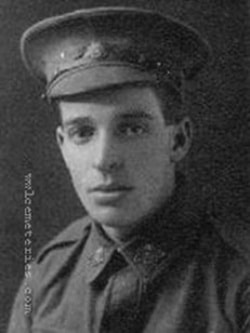
7069 Private
Sidney Harold Lister
17th Bn. Australian Infantry, A. I. F.
14th May 1918.
Plot III. G. 12.
Son of Thomas Sydney Lister and Emily Australia Lister, of 32, Day St., Marrickville, New South Wales. Native of Orange, New South Wales.
His headstone bears the inscription "Till We Meet Beyond The river In Memory Of Our Dear Brave Boy"
Sidney Harold Lister
17th Bn. Australian Infantry, A. I. F.
14th May 1918.
Plot III. G. 12.
Son of Thomas Sydney Lister and Emily Australia Lister, of 32, Day St., Marrickville, New South Wales. Native of Orange, New South Wales.
His headstone bears the inscription "Till We Meet Beyond The river In Memory Of Our Dear Brave Boy"
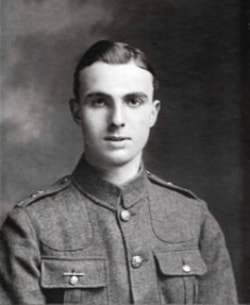
2417 Private
Randolph Spencer Loibl
24th Bn. Royal Fusiliers
28th July 1916, aged 21.
Plot II. C. 36.
Son of Emil and Emma Loibl.
His headstone bears the inscription "The Beloved Son And Brother And So He Trod That Day To God"
Picture courtesy of Lindsey Besley, (Great niece)
Randolph Spencer Loibl
24th Bn. Royal Fusiliers
28th July 1916, aged 21.
Plot II. C. 36.
Son of Emil and Emma Loibl.
His headstone bears the inscription "The Beloved Son And Brother And So He Trod That Day To God"
Picture courtesy of Lindsey Besley, (Great niece)

